The Osteonecrosis Treatment Market is estimated to be valued at USD 295.1 billion in 2025 and is projected to reach USD 476.2 billion by 2035, registering a compound annual growth rate (CAGR) of 4.9% over the forecast period.
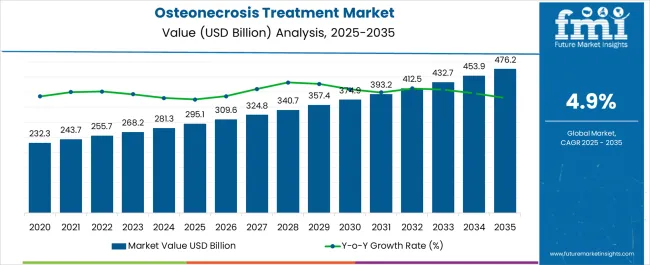
| Metric | Value |
|---|---|
| Osteonecrosis Treatment Market Estimated Value in (2025 E) | USD 295.1 billion |
| Osteonecrosis Treatment Market Forecast Value in (2035 F) | USD 476.2 billion |
| Forecast CAGR (2025 to 2035) | 4.9% |
The osteonecrosis treatment market is expanding steadily owing to the increasing prevalence of bone disorders, rising geriatric population, and growing demand for advanced therapeutic interventions that ensure improved patient outcomes. Early diagnosis initiatives and heightened awareness about the risks of untreated osteonecrosis are driving wider adoption of both pharmacological and regenerative approaches.
Continuous advancements in biotechnology and regenerative medicine, including stem cell therapies, are reshaping treatment pathways by offering improved efficacy and long term recovery potential. In parallel, accessibility to healthcare services and hospital infrastructure in both developed and emerging economies is creating opportunities for sustained growth.
The market outlook remains positive as clinical focus intensifies on personalized medicine, non invasive therapies, and integrated treatment approaches that balance pain management, disease progression control, and functional restoration.
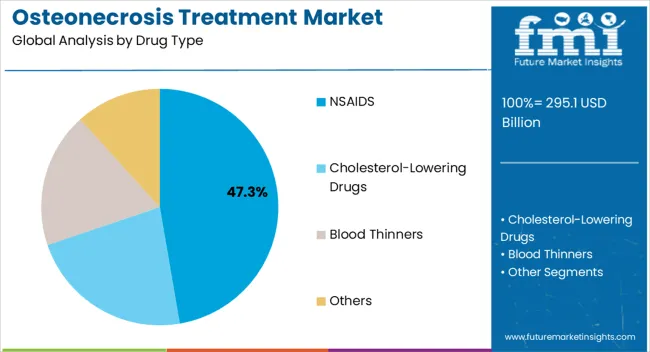
The NSAIDS segment is expected to represent 47.30% of the total market by 2025, establishing its dominance in the drug type category. This position is supported by their widespread use as first line therapy for pain management and inflammation control in osteonecrosis cases.
Cost effectiveness, availability of multiple formulations, and established clinical guidelines have reinforced their extensive prescription rates.
Despite emerging advanced therapies, the consistent role of NSAIDS in symptomatic relief continues to sustain their strong share, making them a cornerstone in the drug type landscape.
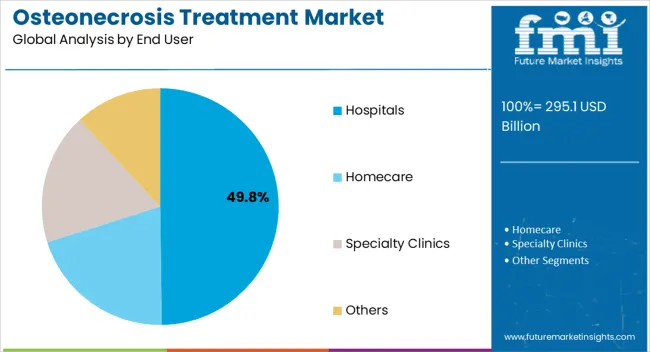
The hospitals segment is expected to account for 49.80% of the total market by 2025, positioning it as the leading end user category. This dominance is due to the availability of specialized orthopedic departments, access to advanced therapies, and the ability to manage complex surgical interventions.
Hospitals serve as primary treatment centers for patients requiring both pharmacological and regenerative therapies, supported by multidisciplinary care teams.
Rising patient admissions for osteonecrosis diagnosis and treatment and the increasing preference for integrated healthcare delivery systems are further reinforcing hospital dominance within this market.
Geriatric Population Growth
The increasing geriatric population is leading to a rise in hip injuries and this is promoting the osteonecrosis treatment market during the forecast period. Further, hip injuries such as degeneration or fractures may result in obstructed blood flow to the bone, leading to trauma-related osteonecrosis and boosting the osteonecrosis treatment adoption trends.
Alarming cases of traumatic injuries and road accidents coupled with excessive consumption of alcohol across the world are anticipated to promote the osteonecrosis treatment market growth. Further, the consumption of corticosteroids excessively also favors the demand for osteonecrosis treatment and therefore surging the sales of osteonecrosis treatment.
Biotechnology Companies
Several measures are taken by biotechnology companies focusing on the development of new treatment options for individuals experiencing osteonecrosis. This is propelling the global osteonecrosis treatment options escalating the osteonecrosis treatment market future trends.
Great Recognition of Non-Invasive Treatment
The demand for osteonecrosis treatment is said to escalate due to rising awareness about non-invasive methods of osteonecrosis treatment. Since this medical condition is asymptomatic and idiopathic in nature, it is increasing the burden on the patient population and is also linked to individuals of any age group.
When osteonecrosis is left untreated, it leads to several complications and therefore there is a high demand for osteonecrosis treatment. This is a core osteonecrosis treatment market driving factor.
Research and Development Activities
The osteonecrosis treatment market opportunities will surge owing to a great number of research and development activities for developing novel drugs. Additionally, technological advancements for enhanced osteonecrosis treatment coupled with increasing demand for non-invasive treatment are some of the other crucial osteonecrosis treatment market driving factors.
Facets Barring the Osteonecrosis Treatment Market
Allocation of Alternative Ways
The main goal after being diagnosed with any disease is to get the condition treated as soon as possible to avoid the progression of osteonecrosis symptoms. As a result, the available treatment is expected to significantly decelerate the osteonecrosis treatment market growth.
NSAIDs are a class of medications commonly used to reduce inflammation and relieve pain. In the context of osteonecrosis. NSAIDs are often prescribed to manage pain and reduce inflammation in affected joints.
In the treatment of osteonecrosis, NSAIDs are typically used as part of a comprehensive management plan that may also include other interventions, such as physical therapy, lifestyle modifications, and in some cases, surgical interventions. Also, the specific NSAID prescribed and the duration of treatment may vary depending on the individual patient and the severity of their condition.
Osteonecrosis is a complex condition that requires specialized medical care, including diagnosis, treatment, and follow-up monitoring. Hospitals play a crucial role in providing comprehensive healthcare services to patients with osteonecrosis.
Hospitals provide a range of treatment options for osteonecrosis, depending on the stage and severity of the disease. These treatments may include conservative measures such as pain management, physical therapy, and lifestyle modifications. Further, in more advanced cases, surgical interventions, such as joint-preserving procedures or joint replacement surgeries, may be performed.
Hospitals serve as centers for research and innovation in osteonecrosis treatment. They contribute to the development of new treatment modalities, clinical trials, and advancements in surgical techniques aimed at improving patient outcomes.
The drug segment has a considerable osteonecrosis treatment market share and is said to be in demand for osteonecrosis treatment during the forecast period owing to being extremely efficient, having fewer side effects as compared to other therapies, and non-invasive nature.
North America is said to be accountable for a significant revenue share as it holds 37.8% osteonecrosis treatment market share due to the high adoption of advanced treatment options and concentration of key osteonecrosis treatment market manufacturers. High adoption of osteonecrosis treatment methods is witnessed in the United States.
The increasing geriatric population coupled with growing awareness of the medical condition and the diagnosis of the same amongst people in this region is said to boost the osteonecrosis treatment market growth. With an increasing number of inorganic growth strategies by market players, North America is anticipated to dominate its position in the osteonecrosis treatment market.
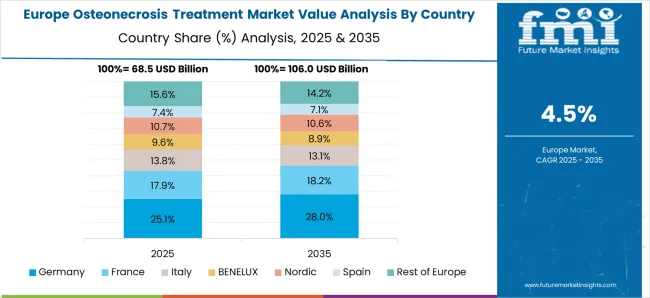
Europe is said to hold a 31.3% osteonecrosis treatment market share. This region portrays a high growth rate owing to the increasing number of surgical procedures such as joint replacements. Increasing healthcare expenditure and the rising number of bone disorders are also responsible for the osteonecrosis treatment market growth in Europe.
The presence of well-established healthcare infrastructure, technological advancements, and the launch of novel drugs and treatment options for osteonecrosis are also propelling the osteonecrosis treatment market growth in Europe.
China is to Witness a 5.9% CAGR during the Analysis Period.
Healthcare providers and researchers in the country are actively involved in developing and implementing innovative treatments for osteonecrosis. China's robust healthcare infrastructure and advancements in medical technology provide a favorable environment for the growth of the osteonecrosis treatment market. Further, the country is witnessing advancements in diagnostic techniques, surgical procedures, and regenerative therapies aimed at improving patient outcomes and preserving joint function.
The government of China focuses on healthcare reforms, investments in research and development, and the availability of skilled healthcare professionals to contribute to the development and adoption of effective treatment strategies for osteonecrosis.
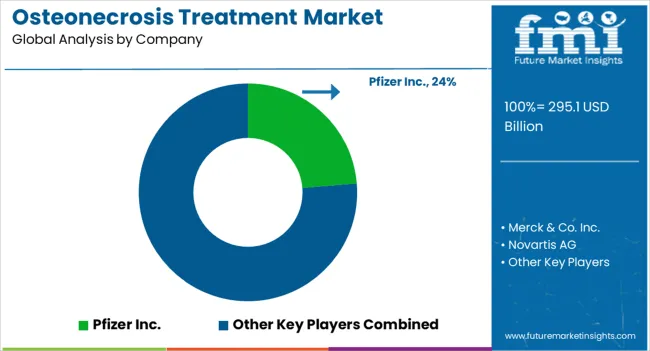
The competitive landscape in the osteonecrosis treatment market is characterized by the presence of several key players and a competitive environment. These players are actively engaged in research and development activities, strategic collaborations, mergers and acquisitions, and product launches to strengthen their market position and gain a competitive edge.
| Attributes | Details |
|---|---|
| Growth Rate | CAGR of 4.9% from 2025 to 2035 |
| Base Year of Estimation | 2025 |
| Historical Data | 2020 to 2025 |
| Forecast Period | 2025 to 2035 |
| Quantitative Units | Revenue in USD billion and Volume in Units and F-CAGR from 2025 to 2035 |
| Report Coverage | Revenue Forecast, Volume Forecast, Company Ranking, Competitive Landscape, growth factors, Trends, and Pricing Analysis |
| Key Segments Covered | Drug Type, Therapy, End User, By Region |
| Regions Covered | North America; Latin America; Europe; East Asia; South Asia; The Middle East & Africa; Oceania |
| Key Countries Profiled | The United States, Canada, Brazil, Mexico, Germany, Italy, France, The United Kingdom, Spain, Russia, China, Japan, India, GCC Countries, Australia |
| Key Companies Profiled | Pfizer Inc.; Merck & Co. Inc.; Novartis AG; Teva Pharmaceutical Industries Ltd; Bone Therapeutics SA; Mylan NV; Regrow Biosciences; Vericel Corporation; Zimmer Biomet; Enzo Biochem Inc. |
| Customization & Pricing | Available upon Request |
The global osteonecrosis treatment market is estimated to be valued at USD 295.1 billion in 2025.
The market size for the osteonecrosis treatment market is projected to reach USD 476.2 billion by 2035.
The osteonecrosis treatment market is expected to grow at a 4.9% CAGR between 2025 and 2035.
The key product types in osteonecrosis treatment market are nsaids, cholesterol-lowering drugs, blood thinners and others.
In terms of therapy, stem cell therapy segment to command 55.6% share in the osteonecrosis treatment market in 2025.






Our Research Products

The "Full Research Suite" delivers actionable market intel, deep dives on markets or technologies, so clients act faster, cut risk, and unlock growth.

The Leaderboard benchmarks and ranks top vendors, classifying them as Established Leaders, Leading Challengers, or Disruptors & Challengers.

Locates where complements amplify value and substitutes erode it, forecasting net impact by horizon

We deliver granular, decision-grade intel: market sizing, 5-year forecasts, pricing, adoption, usage, revenue, and operational KPIs—plus competitor tracking, regulation, and value chains—across 60 countries broadly.

Spot the shifts before they hit your P&L. We track inflection points, adoption curves, pricing moves, and ecosystem plays to show where demand is heading, why it is changing, and what to do next across high-growth markets and disruptive tech

Real-time reads of user behavior. We track shifting priorities, perceptions of today’s and next-gen services, and provider experience, then pace how fast tech moves from trial to adoption, blending buyer, consumer, and channel inputs with social signals (#WhySwitch, #UX).

Partner with our analyst team to build a custom report designed around your business priorities. From analysing market trends to assessing competitors or crafting bespoke datasets, we tailor insights to your needs.
Supplier Intelligence
Discovery & Profiling
Capacity & Footprint
Performance & Risk
Compliance & Governance
Commercial Readiness
Who Supplies Whom
Scorecards & Shortlists
Playbooks & Docs
Category Intelligence
Definition & Scope
Demand & Use Cases
Cost Drivers
Market Structure
Supply Chain Map
Trade & Policy
Operating Norms
Deliverables
Buyer Intelligence
Account Basics
Spend & Scope
Procurement Model
Vendor Requirements
Terms & Policies
Entry Strategy
Pain Points & Triggers
Outputs
Pricing Analysis
Benchmarks
Trends
Should-Cost
Indexation
Landed Cost
Commercial Terms
Deliverables
Brand Analysis
Positioning & Value Prop
Share & Presence
Customer Evidence
Go-to-Market
Digital & Reputation
Compliance & Trust
KPIs & Gaps
Outputs
Full Research Suite comprises of:
Market outlook & trends analysis
Interviews & case studies
Strategic recommendations
Vendor profiles & capabilities analysis
5-year forecasts
8 regions and 60+ country-level data splits
Market segment data splits
12 months of continuous data updates
DELIVERED AS:
PDF EXCEL ONLINE
Treatment-Resistant Hypertension Management Market Size and Share Forecast Outlook 2025 to 2035
Treatment-Resistant Depression Treatment Market Size and Share Forecast Outlook 2025 to 2035
Treatment Pumps Market Insights Growth & Demand Forecast 2025 to 2035
Pretreatment Coatings Market Size and Share Forecast Outlook 2025 to 2035
Air Treatment Ozone Generator Market Size and Share Forecast Outlook 2025 to 2035
CNS Treatment and Therapy Market Insights - Trends & Growth Forecast 2025 to 2035
Seed Treatment Materials Market Size and Share Forecast Outlook 2025 to 2035
Acne Treatment Solutions Market Size and Share Forecast Outlook 2025 to 2035
Scar Treatment Market Overview - Growth & Demand Forecast 2025 to 2035
Soil Treatment Chemicals Market
Water Treatment System Market Size and Share Forecast Outlook 2025 to 2035
Water Treatment Chemical Market Size and Share Forecast Outlook 2025 to 2035
Algae Treatment Chemical Market Forecast and Outlook 2025 to 2035
Water Treatment Market Size and Share Forecast Outlook 2025 to 2035
Water Treatment Ozone Generator Market Size and Share Forecast Outlook 2025 to 2035
Water Treatment Equipment Market Size and Share Forecast Outlook 2025 to 2035
Burns Treatment Market Overview – Growth, Demand & Forecast 2025 to 2035
CRBSI Treatment Market Insights - Growth, Trends & Forecast 2025 to 2035
Water Treatment Polymers Market Growth & Demand 2025 to 2035
Asthma Treatment Market Forecast and Outlook 2025 to 2035

Thank you!
You will receive an email from our Business Development Manager. Please be sure to check your SPAM/JUNK folder too.
Chat With
MaRIA